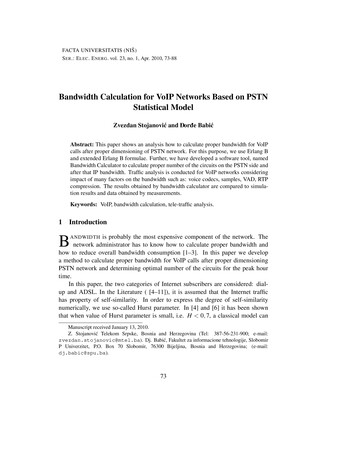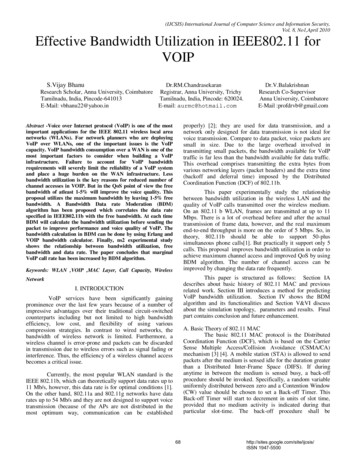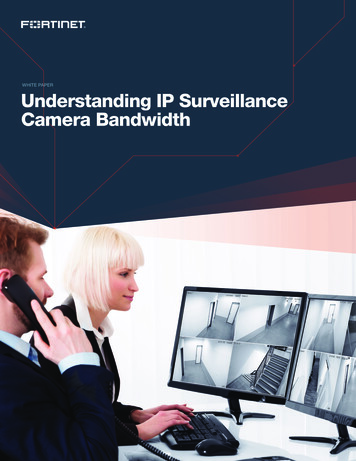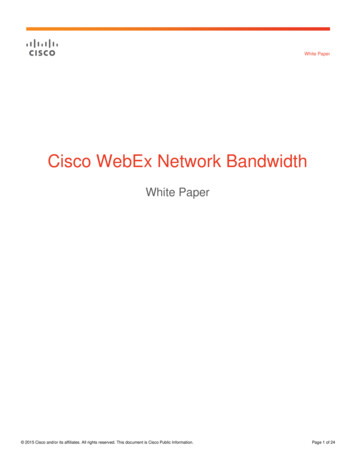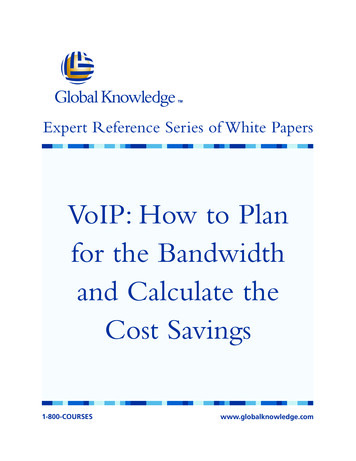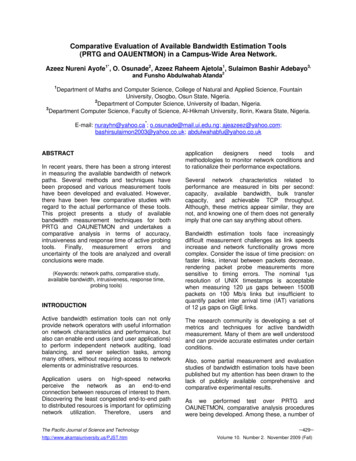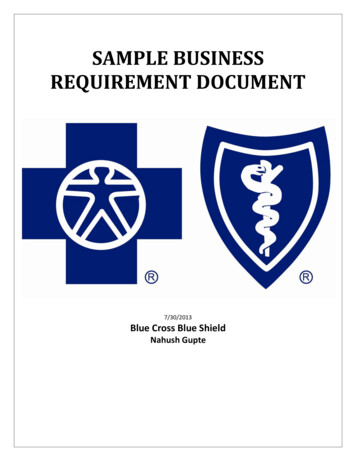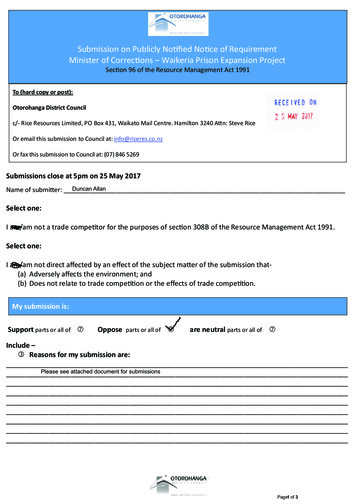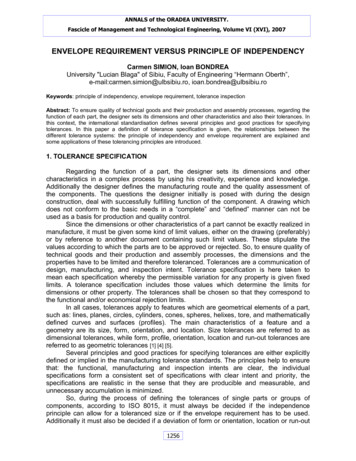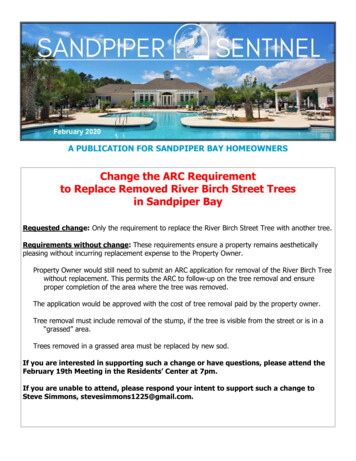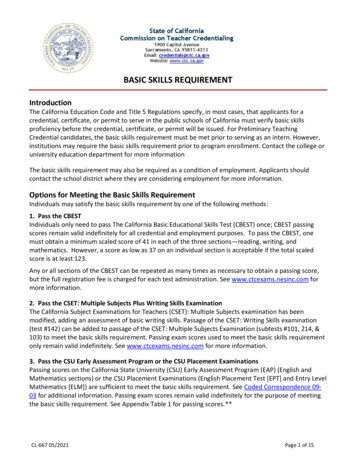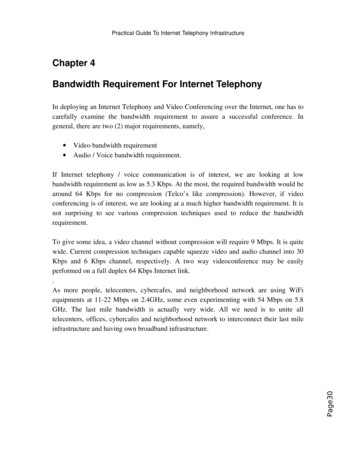
Transcription
Practical Guide To Internet Telephony InfrastructureChapter 4Bandwidth Requirement For Internet TelephonyIn deploying an Internet Telephony and Video Conferencing over the Internet, one has tocarefully examine the bandwidth requirement to assure a successful conference. Ingeneral, there are two (2) major requirements, namely, Video bandwidth requirementAudio / Voice bandwidth requirement.If Internet telephony / voice communication is of interest, we are looking at lowbandwidth requirement as low as 5.3 Kbps. At the most, the required bandwidth would bearound 64 Kbps for no compression (Telco’s like compression). However, if videoconferencing is of interest, we are looking at a much higher bandwidth requirement. It isnot surprising to see various compression techniques used to reduce the bandwidthrequirement.Page30To give some idea, a video channel without compression will require 9 Mbps. It is quitewide. Current compression techniques capable squeeze video and audio channel into 30Kbps and 6 Kbps channel, respectively. A two way videoconference may be easilyperformed on a full duplex 64 Kbps Internet link.As more people, telecenters, cybercafes, and neighborhood network are using WiFiequipments at 11 22 Mbps on 2.4GHz, some even experimenting with 54 Mbps on 5.8GHz. The last mile bandwidth is actually very wide. All we need is to unite alltelecenters, offices, cybercafes and neighborhood network to interconnect their last mileinfrastructure and having own broadband infrastructure.
Practical Guide To Internet Telephony InfrastructureBandwidth For Audio TransmissionAudio will consume a much narrower bandwidth as compared to any video transmission.In this chapter, the typical compressed audio bandwidth will be described. Transmittingcompressed audio via TCP/IP (Internet) infrastructure has been a mode of operation ingetting low cost long distance & international calls.Some of the frequently used audio coding decoding (CODEC) standards are shown in thetable provided by http://www.voipcalculator.com. G.711 is the PCM uncompressed audiocodingalgorithm; itrequires 64kbpsbandwidthor about 80kbpsbandwidthincluding IPheaders. G.723.1 maybe the mostfrequentlyused audioCODEC asit requiresthe least bandwidth about 5 6 Kbps.However, for bandwidth conservation, a higher audio compression, such as, G.723.1would of Interest. G.723.1 may provide the one of the highest bandwidth compression.With current Digital Signal Processing (DSP) technology, the computation time can bereduced and, thus, not significantly degrade the Mean Opinion Score (MOS) of the audioPage30Mean Opinion Score (MOS) is the approach to measure the reception quality of theaudio. A better quality (higher MOS) will likely to be obtained at lower compression rate,such as, G.711. Low compression or uncompressed audio leads to wider bandwidth and,thus, lower computational requirement (lower Mega Instruction Per Second / MIPS).
Practical Guide To Internet Telephony InfrastructurePage30quality. It is not surprising to see most of Internet telephony communications currentlyperformed using G.723.1 compression.
Practical Guide To Internet Telephony InfrastructureBandwidth For Video TransmissionSome of the good references for bandwidth requirement for video transmission overInternet are,http://www.crs4.it/ luigi/MPEG/mpeggloss h.htmlhttp://www.4i2i.com/h263 video codec.htmhttp://www mobile.ecs.soton.ac.uk/peter/h263/h263.htmlThose who like to read the original H.* standards, it should be available from theInternational Telecommunication Union (ITU) http://www.itu.int. It may be costly to getthe standard direcly from ITU. A better way in getting the standard would be to dogoogle search using H.261, H.263, or H.323 as keywords.There are at least two (2) major standard in sending video through narrow band channel,namely, H.261 – usually used for ISDN channel with speed n p x 64Kbps; where p may be1, 2, 3, , 30.H.263 – aim for a much lower bandwidth video transmission at 20 30 Kbps andup.H.263 may be one of the frequently used video compression for Internet based videoconferencing. Some of the important notes to be bare in mind are, Black and white video will likely to consume much less bandwidth as compare tocolor video transmission.Low video frame per second (fps) will consume less bandwidth than higher frameper second (fps).Page30A good video is usually transmitted at around 30 frame per second (fps). Uncompressedvideo at 30 fps will consume about 9 Mbps of bandwidth.
Practical Guide To Internet Telephony InfrastructureCalculate Internet Telephony Bandwidth RequirementAbility to calculate therequired bandwidth orInternet telephony linesneededforcertainmaximum traffic load.Fortunately, some sites,suchas,http://www.voipcalculator.com & http://www.erlang.com/calculator/, provides a freeaccess to their calculation subroutine through their web. There are several aspects ofInternet telephony infrastructure can be calculated, such as,Lines and Bandwidth calculator.Erlangs and Bandwidth calculator.Minutes and Lines calculator.Erlangs and Lines calculator.Page30
Practical Guide To Internet Telephony InfrastructureTheLinesandIPBandwidth Calculator canbe used to estimate thebandwidth required throughan IP based network for afixed number of voicepaths. There are severalcoding algorithm can beused to for coder decoder(CODEC) of the audio, thefavorite CODEC are G.723.1 and G.729. Thefrequency at which thevoice packets are transmitted have a significant bearing on the bandwidth required. Theselection of the packet duration (and therefore the packet frequency) is a compromisebetween bandwidth and quality. Lower durations require more bandwidth. However, ifthe duration is increased, the delay of the system increases, and it becomes moresusceptible to packet loss; 20ms is a typical figure.Page30In the Voice Path IP Bandwidth (ACELPS) IP Bandwidth (MP MLQ)example116 kbps18 kbpscalculated232 kbps35 kbpsIP348 kbps52 kbpsbandwidth,464 kbps69 kbpsthe severalvoice paths with packet duration 30 millisecond (1 sample) with G.723.1 (ACELPS) 5.3kbps or MP MLQ 6.4 kbps will be shown. We basically are looking at a maximum offour (4) voice path in a 64 kbps bandwidth. The above calculation is not taking accountany reduction due to Real Time Protocol (RTP) header compression and multiplexing.
Practical Guide To Internet Telephony InfrastructureMinutesandLinesCalculator The Minutesand Lines Calculator can beused to estimate the numberof voice paths that shouldbe provided through a widearea network if we knowthe number of minutes ofcalls which the two voiceswitches interconnected bythat network will generateeach day.Networkdesigners need to ensurethat sufficient bandwidth is available through a network to transport enough voice pathsto carry the voice traffic during its busiest hour.Lines402387654321The busy hour factor is the percentage of daily minutes that areoffered during the busiest hour of the day. 17% (the default) is areasonable figure for a business that operates an 8 hour workingday, but a higher figure could be entered if the business inquestion operates a shorter working day, or if frequent calls arebeing made to a different time zone. Blocking target is the ratioof calls that will be blocked because no lines are available. 0.010(the default) means that 1% of calls would be lost. This is anormal figure for traffic engineering, but other figures can beentered into this edit box. Some example of the calculated resultis shown in the figure. We basically have about 300 minutesbusy traffic for four (4) VoIP lines.Page30Minutes1000050001000882670476300158523
Practical Guide To Internet Telephony InfrastructureIn addition to the abovefreecalculators,http://www.voipcalculator.com is offering a commercial software package that simplifiesthe complicated design process involved in creating effective voice networks that arebased on either traditional circuit switching or Voice over IP, called Westplan. Allcalculations are based on an inter nodal traffic model that we can specify ourself, orallow Westplan to estimate. Westplan supports the following features:Point and click network diagramsVoice over IP bandwidth calculationsLayer 2 support for PPP, Frame Relay, Ethernet, ATM and HDLC.Analogue, T1 and E1 transmission facilitiesUser definable routing rulesRTP compression for VoIPFull justification reports for each analysisClear printed reportsContext sensitive helpPage30
Voice over IP bandwidth calculations Layer 2 support for PPP, Frame Relay, Ethernet, ATM and HDLC. Analogue, T1 and E1 transmission facilities User definable routing rules RTP compression for VoIP Full justification reports for eac
